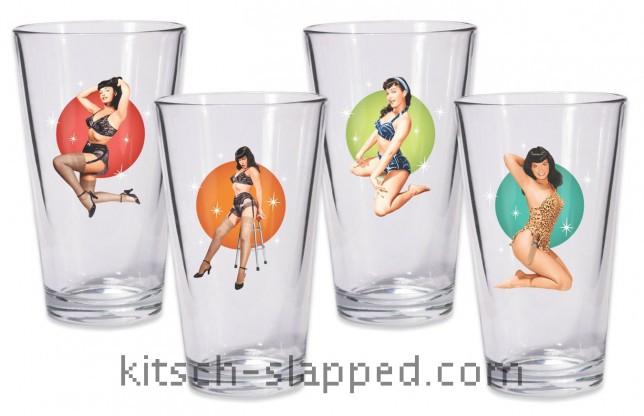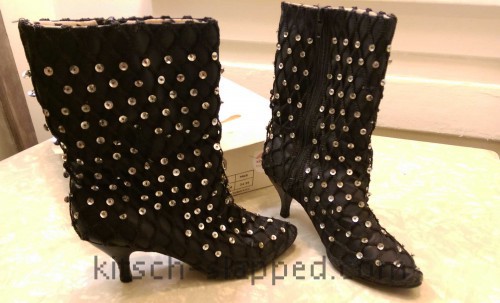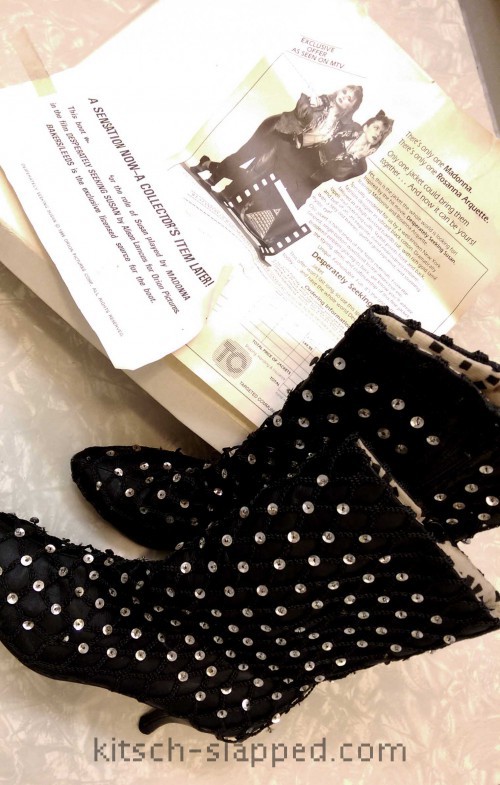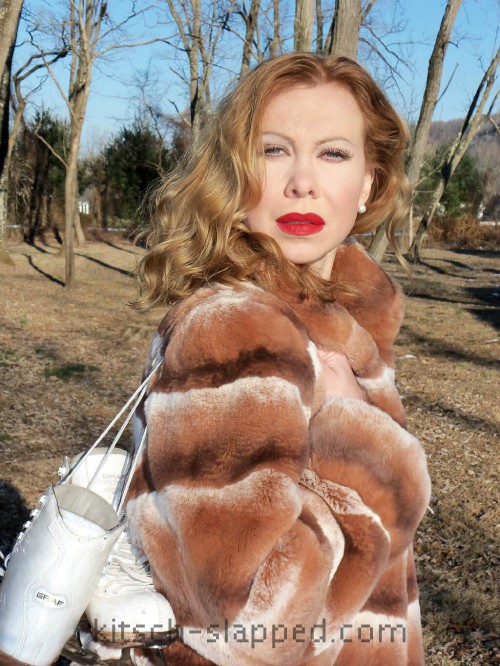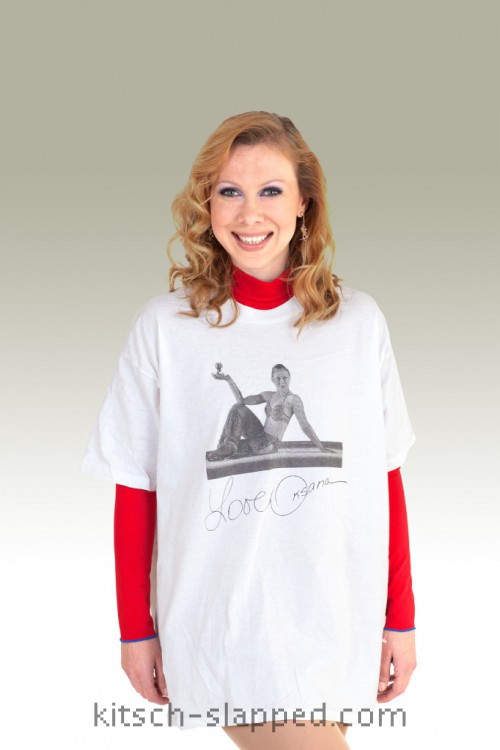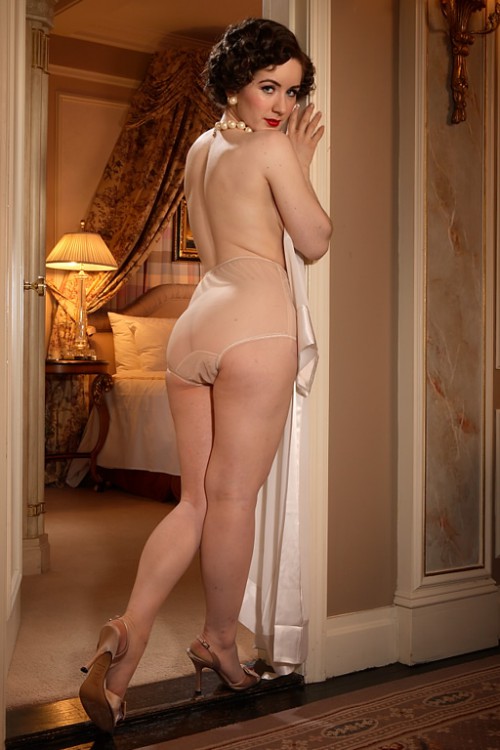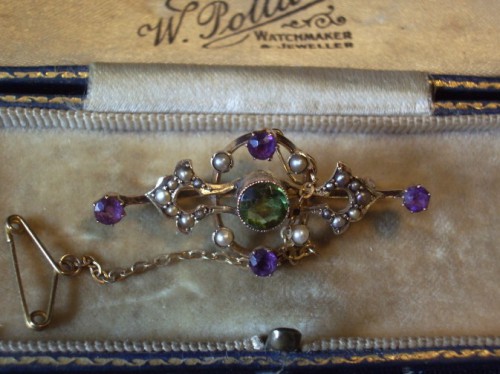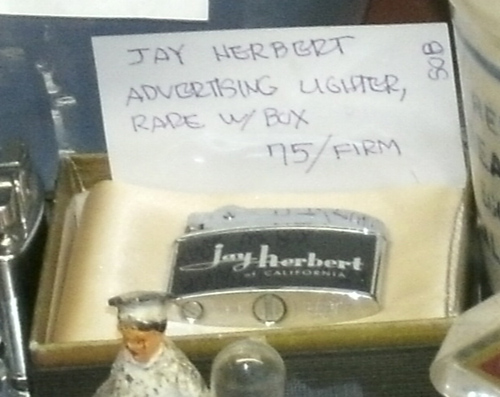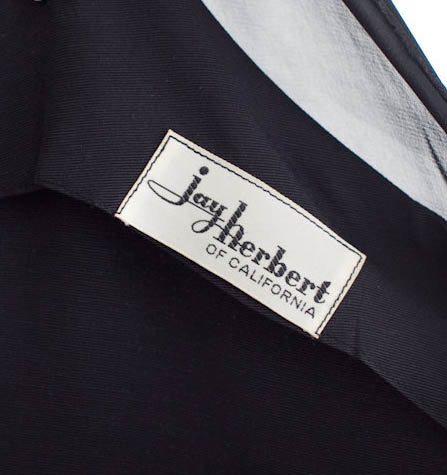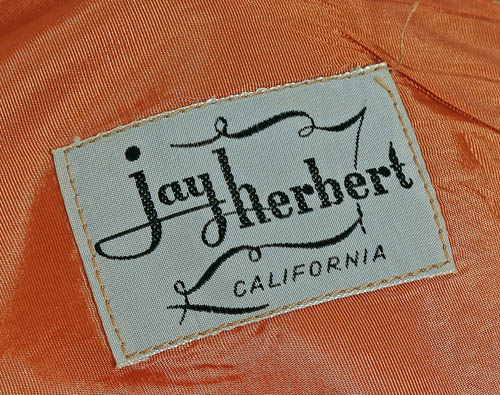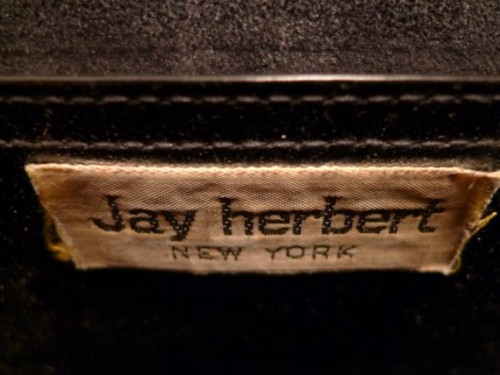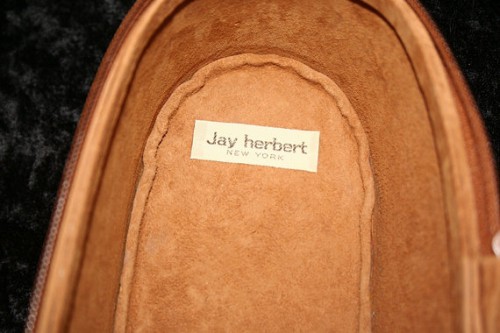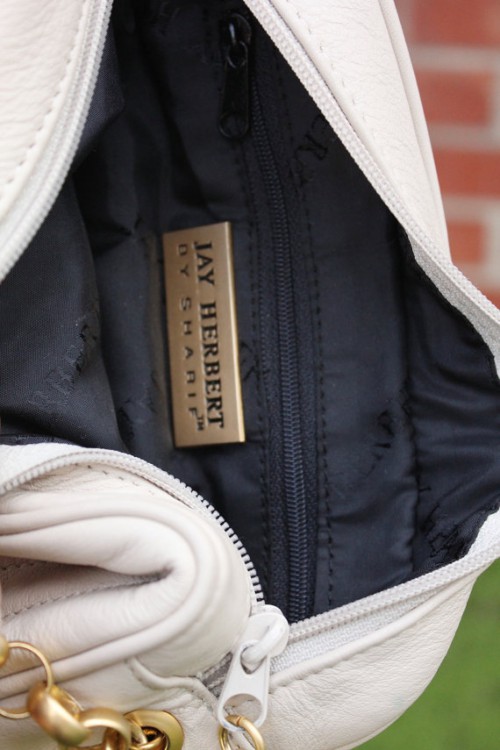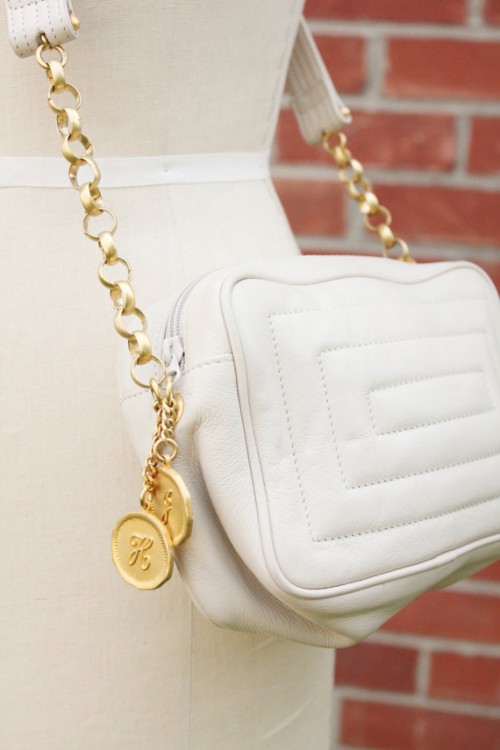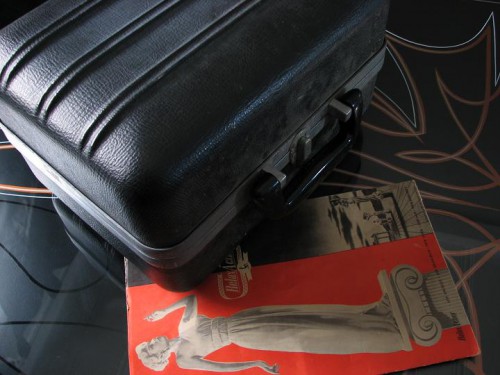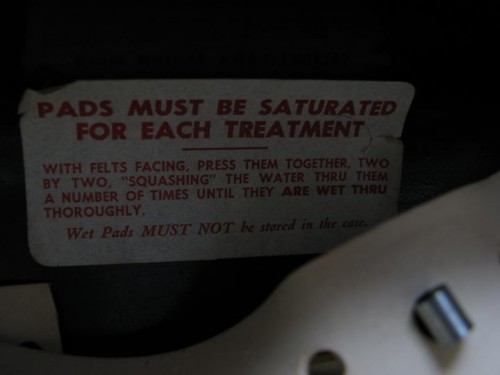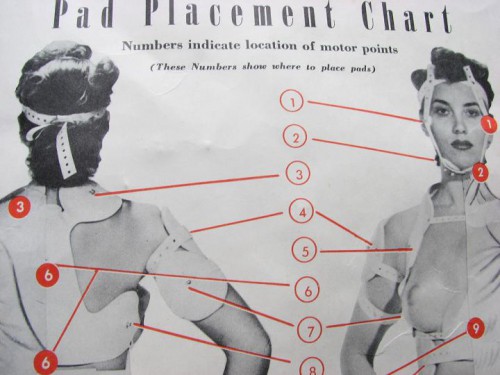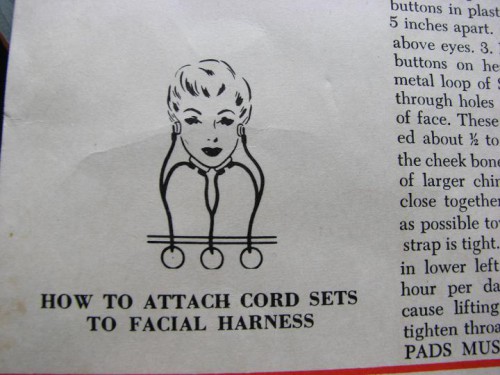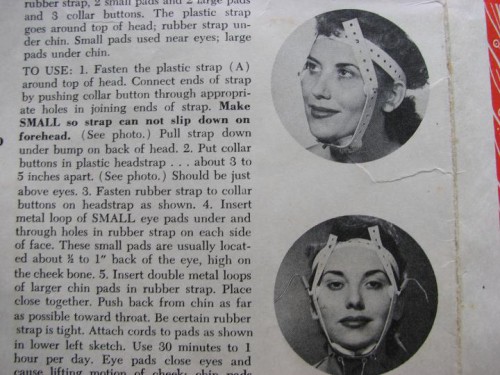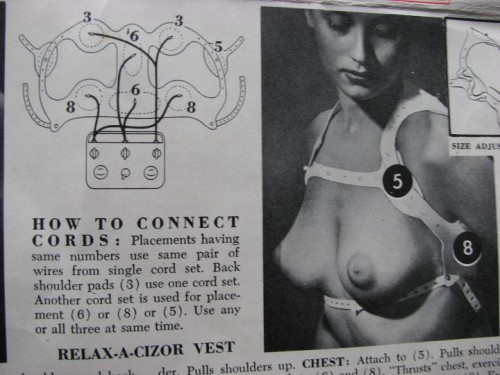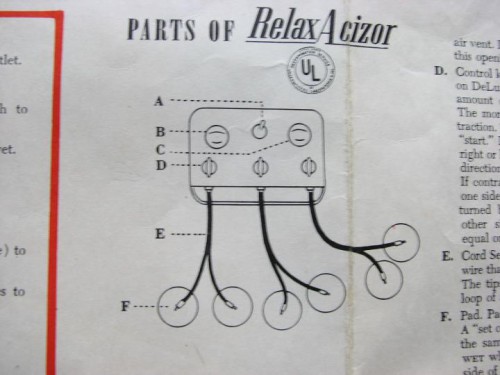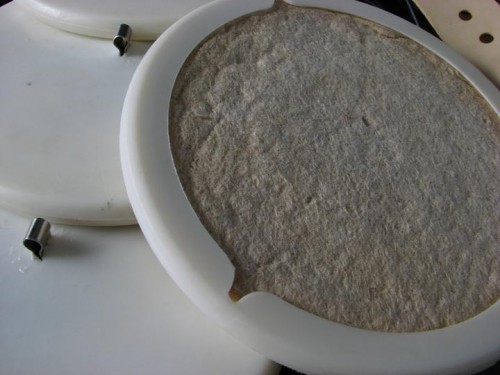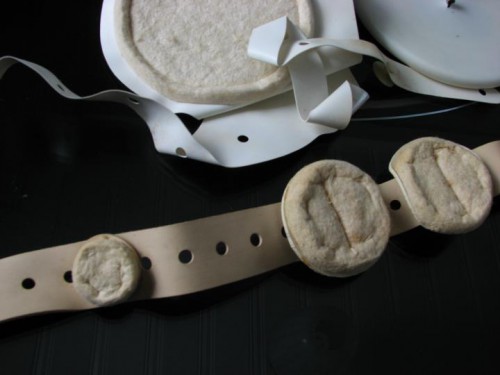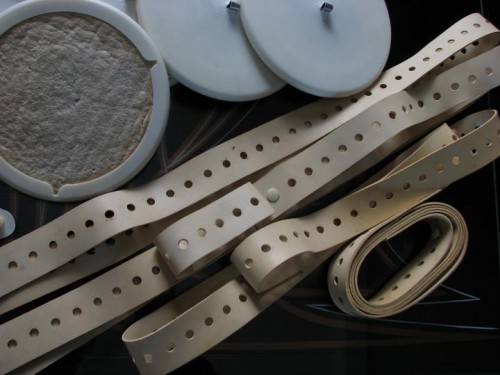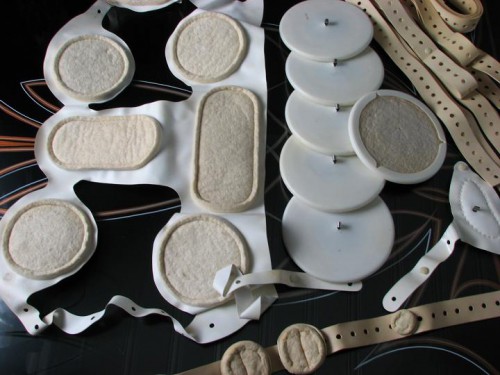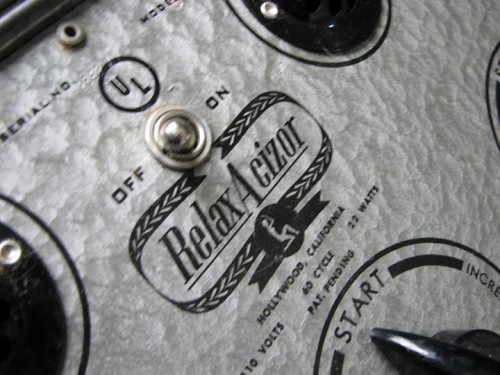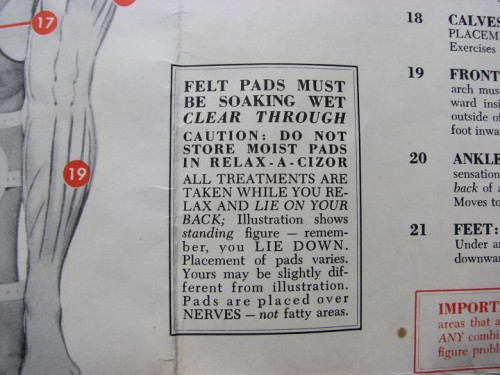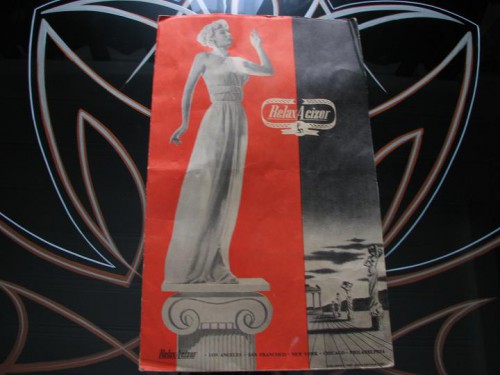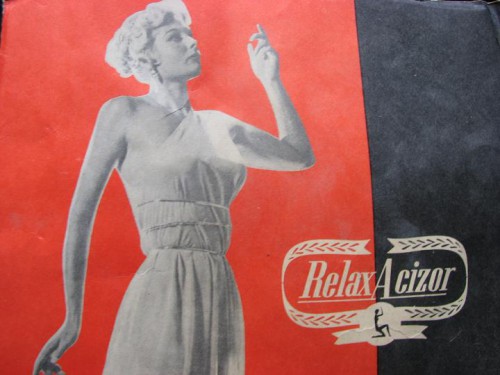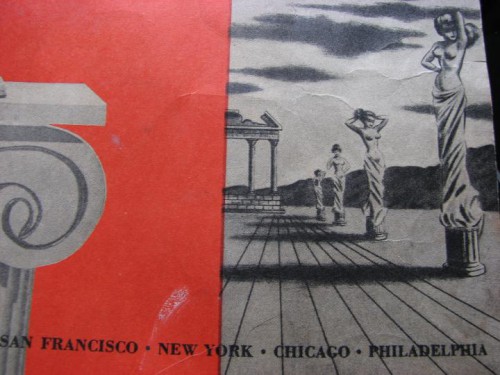Bettie continues to “wet” appetites and satiate thirsts, so why should she not continue to adorn sets of glasses?
Tag: shopping
Are You Desperately Seeking These Boots, Susan?
Five years ago I wrote about the fashions in 1985’s Desperately Seeking Susan — and ever since, the popularity of that post seems to have grown. Nearly as fast as the cult classic itself, I daresay. Halloween costume time especially drives interest, I suppose. However, my main interest in posting this today is because — hold onto your hats! — I’ve a pair of the very rare black sequined Desperately Seeking Susan boots up for sale in our Etsy shop! (It includes some ephemera too!)
There Will Always Be One Queen Of Ice Skating
For me, the best thing about the Olympics is the figure skating. And nothing & no one in ice skating compares to Oksana Baiul. Into the drama of the 1994 Lillehammer Winter Olympics stole a 16 year old Oksana Baiul, taking the gold and our hearts.
It’s hard to believe it’s been 20 years already…
Baiul is still active (you can like her Facebook page and follow her on Twitter), still glamorous, and she’s celebrating 20 years of Olympic gold with her Oksana Baiul Collection.
Perhaps my favorite performance of Baiul’s, the legendary Arabian performance.
What To Wear Under Your “Mom Jeans”
I don’t agree with Oprah about many things; among them her attitudes about domestic violence (which Alessia articulates so well) and “mom jeans.” So while I was not thrilled only to have copies of People Magazine to flip through while in a waiting room recently, I was thrilled to see female celebrities rocking the “mom jeans.”
“Mom jeans,” you may or may not know, are jeans that go up to your waist and, so, actually fit. Some of us have to go out of our way to find these jeans — but if People is any indication, soon we will have them back in ready supply.
No matter what Oprah and others might say, pants that fit your curves, rather than being slung around and beneath them, are sexy. Just not having your unmentionables (or actual body) on display and ready to be discussed is a comfort that adds confidence; am I right, ladies? In fact, one of the best things about these “high-waisted” jeans, is the inability to spot whale-tails. And this also means the so-called mom jeans allow a woman to wear underwear that fits.
With mom jeans, you can wear panties which cover your entire bottom as well as go up to your waist. You might call them “grannie panties,” but in lingerie fashion terms these vintage styled panties are called “full-cut” or “full-coverage” panties and they make visible panty lines (VPL) things of the past.
And these vintage-styled panties can be completely sexy. They can feel sexy and look sexy. Like these ultra sheer panties from Secrets In Lace.
The combination of modest in public “mom jeans” and skimpy in private “grannie panties” quite suits the way I prefer to live my life.
The Retro Sheer Panties are made of 100% nylon, come in five colors (Beige, Black, Pink, Red, White) and seven sizes (S,M,L,XL,2X,3X,4X) — and they are only $11.99.
Secrets In Lace also makes other full-cut panties, including sheer ruffled and embroidered varieties, as well as slinky satin ones. Go ahead, get your sexy grannie panties on. And your mom jeans. If you can find them.
Busty Girls Held Hostage By Retailers & Economy
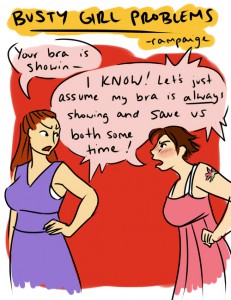 I don’t want to keep picking on Lane Bryant, but a few things need to be said.
I don’t want to keep picking on Lane Bryant, but a few things need to be said.
Where I live, Lane Bryant is the only store which carries bras over the size of DD cups. Supersillious of the majority of stores to stop at the very size of the average American woman; surely there are great numbers over that size. You can’t open a browser window to a health site or news page, turn on TV or radio, or leave the house and not know how big we American’s are; myself included. It’s not just the USA, and weight isn’t the only reason for the overly-developed bosoms in developed nations either. If I were a CEO of an apparel manufacturer or chain, I’d find limiting bra sizes to exclude such a huge part of the market not only worthy of eyeball rolls, but I’d roll some heads too. It’s unacceptable. But the fact is, there is only one store in the whole metropolitan area which sells bras larger than double-d cups; and that store is Lane Bryant.
So I’m shopping for bras at Lane Bryant, which means finding one that fits. I can’t just use the size that’s on my current Lane Bryant bra, because it no longer properly fits — in fact, none of my Lane Bryant bras seem to fit after say a dozen washings. The center piece pulls away, no longer sits flush against my breastbone. I know from Ali Cudby, and the aches and pains in my own body, as well as how my form looks, that this is no good.
Maybe this is all just a result of the cheapening of clothing, thanks to WalMart. But I hope not.
There are two sales associates at my disposal, one presumably training the other in this nearly-empty store. I try to ask them for some suggestions. I know from decades of previous retail work, that they aren’t really trained for much past working the register and meeting sales quotas, but I figure they know from their own figures and customer comments or complaints which bras are least likely to have the problem.
I describe my problem and the clerk-in-training eagerly replies that her bras all do the same. Rather shocked, I begin to explain that that is not how a bra is supposed to fit — that’s when the more experienced clerk interrupts me.
“When you’re talking about an E cup or larger, that’s an awful lot to ask of a bra,” she says.
Now I’m even more shocked.
“Yes…” I begin, “But the bras aren’t just supposed to ‘be larger’ but actually fit. When bras don’t fit right, there are aches and pains… Plus the rest of your clothes look sloppy.”
“Yes,” she replied, with a tense smile, “But at that size…”
“Well, if you wear a size 26 pants, they still have to fit, right?” I challenge her. “I mean the crotch is where it’s supposed to be, not at the knees. The pants are larger — but not just larger. They have to fit.”
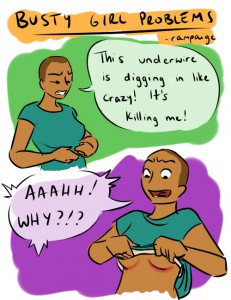 In that magical retail blend of “the customer was always right” and “if you have nothing nice to say…” she had nothing to say in reply. The other clerk kept a smile on her face, but, taking her clues from her superior, she too was silent.
In that magical retail blend of “the customer was always right” and “if you have nothing nice to say…” she had nothing to say in reply. The other clerk kept a smile on her face, but, taking her clues from her superior, she too was silent.
Now I was more than shocked; I was disturbed and saddened. Here’s a plus-sized lady working in a shop selling plus-sized clothing, and she’s making excuses for accepting clothing that doesn’t fit.
I don’t know whether the clerk’s stance was some reflexive act in defense of the company she works for; or if it was a sad commentary on average-sized women, working in a fashion store or not, who are told they are “large,” “plus sized,” or even “fat” who feel they aren’t worthy of clothing that actually fits them.
In any case, all that was left for me to do was to try on bras until I found one that I could pronounce “fitting” and worthy of purchasing; then take it home and see if it fares any better than the others had. (My fingers are crossed that it does; but the past few years has taught me not to hold my breath.)
There are plenty of reasons right here in this one shopping experience to explain Oprah’s claims that 85% of women are wearing the wrong size bra. (There is some confusion regarding the Oprah statistic and the much touted 80% figure which may have started with a Wacoal study in 2005. Also, here’s a medical study regarding women with thoracic spine or posterior chest wall pain which says of the 80% who wear ill-fitting bras, 70% are wearing bras that are too small, and the BBC reports that 100% of women going into a hospital clinic for breast reduction surgery were wearing improperly fitting bras. Clearly this is an issue!)
Women may educate themselves about how a bra should fit, but the real question remains: If women, especially big busted women, are limited access to a wide array of bra sizes, how can they find those that properly fit?
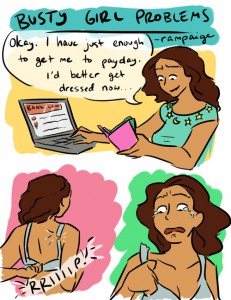 The reality is that ordering dozens or even a handful of bras to try on is not an option for the majority of women in this country. WalMart may have cheap bras (both in terms of quality and price), but even online, the largest size they have is a 48DDD and only in one bra. Most bras over a DD cost $30 to $45 (and, of course, much higher). Few women have hundreds of dollars to tie-up in ordering bras — even if they are returning most of them. We are the 99%, or the 80%, if you prefer; not the 1%. So we remain held hostage by the inaccessibility.
The reality is that ordering dozens or even a handful of bras to try on is not an option for the majority of women in this country. WalMart may have cheap bras (both in terms of quality and price), but even online, the largest size they have is a 48DDD and only in one bra. Most bras over a DD cost $30 to $45 (and, of course, much higher). Few women have hundreds of dollars to tie-up in ordering bras — even if they are returning most of them. We are the 99%, or the 80%, if you prefer; not the 1%. So we remain held hostage by the inaccessibility.
What worse, we are women who already held hostage by our breasts. Along with our vaginas and uteri, our breasts are legislated. We dare not bare our breasts in public, not even to feed our children. Many school and employment policies have dress codes which require female employees to wear bras. (We make 77 cents for every dollar a man does, and we are required to wear garments with a heftier price-tag than men too.) Gawd forbid we show a bra strap. All because breasts not bound enough can be too sexy or whatever; especially larger breasts. As if there weren’t enough judgements from pigs, we as a society allow judgements about female breasts.We’re supposed to blame and contain breasts as opposed to make men responsible for their silliness or worse. It’s all the American versions of the burka and sharia law.
As if having larger breasts weren’t problematic enough, just finding the right bras to do all this — as well as prevent the pains that insurance typically won’t cover — is thwarted by not having access to bras in our size range.
All images via Busty Girl Comics — check out the Busty Girl Comics store too!
Lane Bryant Needs Tips On How To Be A Gold Digger
 So, on the 13th of this month, Lane Bryant sent me an email saying they “missed me.” They don’t know me personally; they just missed my money as I hadn’t shopped there in awhile.
So, on the 13th of this month, Lane Bryant sent me an email saying they “missed me.” They don’t know me personally; they just missed my money as I hadn’t shopped there in awhile.
In the email, there was a 40% off coupon. It was just 40% off one regular priced item, but I had received a gift card for my birthday, so I wanted to print the coupon out to take it to the store with me. No newbie to how this stuff goes, I went to use “print preview” to make sure the barcode part of the email would actually be printed. The print preview did as I feared, only showing the model and not the barcode. So I clicked to “view the email online” — and that’s when the proverbial shit hit the fan.
The page on the Lane Bryant site was without an image. All I got was the website header and footer — just a big hunk of whitespace in the middle. So I went back to the email.
Guess what?
The image had disappeared.
Perhaps the gremlins which run the interwebs believed that use of print preview meant I had printed it — and only one coupon is allowed. But I hadn’t printed. So now what?
Since this was a coupon from a national chain that I was going to have to use at my local Lane Bryant store, I called them. I figured that as I’d be using the coupon there, they’d be familiar with the process and maybe even have a spare or blank coupon for such things. No, they did not. Instead, they gave me a customer service number. Only that customer service number is for Lane Bryant card holders, which meant that not only was it difficult to get past the voicemail prompts, but when I finally did reach a person, she couldn’t do anything to help me. I doubt very much that even had I been a Lane Bryant credit card holder that she could have helped me as her understanding of how email lists etc. work was very limited.
“Just sign up for the newsletter again,” she said.
“I don’t think you understand,” I began patiently. “You see, the email was about ‘missing me’, so I would need — along with a new email address to join under — to shop at the store and then not shop at the store for six months in order to be ‘missed.”
She put me on hold.
When she came back, she suggested I call my local store. To which I replied that I’d already done that; that’s how I got the number I called to reach her.
Pause.
“Well, all I can suggest is to get a new email address to sign up for the newsletter with.”
Umm, didn’t we already cover that?
Was there another number for customer service — one not related to credit cards? Would a supervisor be able to help? Was there any other Lane Bryant number to call at all?
No. No. No. (Though it turns out there is another Lane Bryant customer service number; sadly no one gave me that number or even seemed to know it.)
So, Lane Bryant, thanks so much for missing me and creating a marketing disaster.
Instead of making me happy, making me feel treated to something special (even though we all know it’s just about you getting your hand in my pocket and getting my money), you peeved me off. For all the efforts of your team of marketers who want to build relationships with me, you forgot some basic rules. Rules gold diggers know:
1. Be accessible. Yeah, “not to available” might lend an air or mystery; but no means of contact — or having so many hurdles to contact, just means the man with money grabs another honey.
2. Smile nice when reaching into my pocket. Lean in and make me want you to put your hand there… Lift the bills out and take them. Don’t stand so far away, don’t place your other hand over the wallet so that the whole deal is a struggle.
3. Know what you are doing. That includes any of your cohorts (aka employees). Don’t make the mark have to do so much work. Unless our relationship is based on some S&M kink, I shouldn’t be frustrated and sweaty just trying to give you my money.
4. When all is said and done, I should be left with an empty wallet and a smile, dreamily looking forward to next time.
If it weren’t for the fact that I have a gift card, and a rare window of time to shop, it would be a lot longer for you to see me again.
Suffering Suffrage Jewelry
This antique pin with peridot, amethysts, and pearls set in 9 carat rose and yellow gold is gorgeous — but it’s not (necessarily) suffragette jewelry, as the seller claims.
FYI, the antique brooch is hallmarked Chester 1908, marked 375 and the makers mark is PP Ltd.; it measures about 1 3/4 inches long and is 3/4 inches wide.
In short, buy it if you love how beautiful it is; not because of the myths.
Vintage Jay Herbert
On a recent visit to Fargo’s Antiques On Broadway, I spotted this vintage lighter (still in the box) advertising Jay Herbert of California and the stylized name looked familiar…
A quick image search on Google, and I received the instant gratification I sought: vintage fashion labels for Jay Herbert of California.
My favorite is this fancier version in which the scroll work at the bottom somehow remind me of scissors. It still holds it’s logo value today, for somehow, in all my perusals of vintage fashions over the years, I retained the sight of it enough to recognize it on the lighter.
If I had to guess, I’d say the fancier labels are the older ones. But it would only be a guess. For aside from department store ads in old newspapers announcing the Jay Herbert of California brand, there’s scant information available on the fashion house.
One thing is for certain, though: Jay Herbert was not a fashion designer or even an actual person. Buried in a precedent setting legal case regarding the definition of an employee (at least for tax purposes), I discovered that Jay Herbert of California was the business name of partners Herbert Owen and Joseph Silverstein who “engaged in the manufacture and sale of ladies’ dresses” in 1960.
That technically means that references to Jay Herbert as a designer are false.
But there’s even more ambiguity…
It appears that Jay Herbert of California began appearing in vintage department store advertisements in the late 1950s but by the mid 1960s they fade away… And decades later, in the 1980s, the name Jay Herbert appears again — on handbags and wine caddies — but now simply as Jay Herbert, New York.
I’m rather smitten with this vintage or retro Jay Herbert New York handbag.
I’m not sure if this Jay Herbert, most known for their coveted quilted Chanel-inspired handbags, is related past anything but name. Trademark searches show no records for the name Jay Herbert, Jay Herbert of California, or Jay Herbert New York. The name could have been sold, licensed, or, having no protections, even just capitalized upon as having some recognition with retailers.
More contemporary handbags appear with metal tags bearing the Jay Herbert name and metal “coin” logos — but these handbags and purses are “by Sharif.”
Sharif, like Cher, uses only one name. The designer bags are sold mainly (if not only) on HSN. The designer incorporated as Sharif Designs Inc. in 1979, but it has a family history dates back to 1827 in Egypt.
Personally, I prefer the vintage bags over the new ones, and the vintage fashions even more. But it’s the vintage labels and logos I love most of all.
I hope this helps you with your Jay Herbert shopping and collecting. If you can add any information, please do!
Image Credits: Simple Jay Herbert of California label via Half A Second Art and Vintage; fancy Jay Herbert label via Timeless Vixen Vintage; Jay Herbert New York purse label via Barefoot & Vintage; Jay Herbert New York wine caddy label via DJVintage; retro quilted Jay Herbert purse via A Little Luxury; two photos of Jay Herbert by Sharif metal tags via Mr. Mister Vintage
Sockingly Awesome, Wretched Vintage Beauty Quackery Device: The Relax-A-Cizor
Any of these old beauty gadgets or quack medical items draws my interest — but when an electrical item demands you make the pads which attach to wires wet, well, I’m in love!
I’d love to own this not-so-little gem, but it’s beyond my budget. *pout* Here’s an awesome description from the seller:
The Relax-A-Cizor is an Electrical Muscle Stimulator. They date from the late 1940’s to the early 1970’s, and sold for $200- $400.
It claims to reduce girth by giving electric shocks to the muscles. Wet pads are strapped or placed on the body, attached by cords to a power source.
Pads can be placed on the stomach, thighs, arms, etc., even the face. Then you just lie there and electric shock yourself into a fabulous figure, yay!
Sounds scary, huh?In 1971 the FDA declared the Relax-A Cizor to be dangerous, causing or aggravating medical conditions.
This is after selling thousands of units for decades!
The FDA ordered the destruction of units, or for them to be made inoperable. They also banned the resale of already purchased units. So, given all that information, this auction is for the purpose of Collecting Medical Quackery Items only. This Relax-A-Cizor is not being sold as an excercise or fitness machine.
This auction contains:
the original hard case
electrical console with dials, toggle, and inputs
The original instructions
6 disks with pads
face pads and strap
chest pads and vest
extra straps
chin pad
cordsThe instructions have gorgeous drawings of statue like women, some naked, I love the art, fabulous! There are photographs of pad placement in these instructions, including some nudity.
The funniest thing about the instructions (in my opinion), is the lack of warnings. In fact, the only warning is to NOT store wet pads in the box. The only other warnings are to make sure to lie down, and to get the pads thoroughly wet, nothing about being shocked!
This is a true medical oddity.
This Relax-A-Cizor is in excellent condition. The pads and straps have some discoloration from use, age, and storage. I’m not sure if this unit is complete, there is no item list. The paper instructions are in excellent condition, there is a hand written note taped to the inside. The case is in excellent condition.
I do not know if the unit works or not. There is some broken and burnt looking ends on the wires.
I soooo NEED this!
Images and description via Strange Vintage.
The Haves & The Have Not (Yet)s Of EBay
Recently eBay released this infographic based on information gathered by Hunch, a recent eBay acquisition, on “the core differences between people who have bought or sold something on eBay vs. those who haven’t yet.” The data is then split between those ho Have Used eBay and the eternally optimistic those who Haven’t Yet Used eBay.

Aside from the marketing insight, I thought this would be worth noting here as the Haven’t Yet Used eBay people in this survey are 35% more likely to be female.
There are some interesting things to note — but what would be far more compelling, not to mention useful, would be to include information about shopping online in general (the Haven’t Yet Used eBay folks may just not shop online). But if they use Amazon, Etsy, TIAS, or other shopping sites or marketplaces that would say something else entirely. Perhaps the “non competitive” stance in the survey means those who Haven’t Yet Used eBay don’t like auction formats? (This is reinforced by the response of “31% more likely to never have attended a live auction.”) So why not take a look at less competitive purchasing environments?
What is most interesting, however, is that this data seems to confirm that those most likely to use eBay are those seeking unique items, such as antiques and vintage collectibles — while those who have not seem to be more likely to shop Walmart for a perceived “deal”. Why then would eBay continue to shift away from its target market and court sellers of last year’s navy blue sweaters, etc., when those shoppers clearly are not using eBay?
In many ways, the not yet used seem much more like a demographic stereotype of young women: single, shopping for clothing in bulk, but at low prices, (not investing in wardrobes), and who consider shopping a social experience, (eBay does not yet have a “lunch with the girls” option).
However, based on a few references to older musicians, the Today Show reference, etc., this group also indicates a more mature woman who was older at the advent of the Internet, has kept herself busy without it while raising children, etc., and now finds herself behind the technology curve — or just continuing happily without it.
In any case, I am reminded of a Dan Hess quote:
Retailers turn a profit by bringing in new merchandise and pushing self-purchase categories like lingerie, shoes and denim. Retailing is an event-oriented business. Look at any national holiday, retailers seize on it and find a way to market heavily and drive traffic.
No matter how you slice the Haven’t Yet Used eBay pie, you just can’t help but see that some sort of social event aspect is needed for eBay to make the “yet” in Haven’t Yet Used eBay more than a positive attitude.
This isn’t a new idea. Even though Buddy Shopping has come and gone, other social shopping sites continue to try. Usually these are communities devoted to a specific fashion passion, but there are sites like Kaboodle and ShopSquad which offer social connection with a bit of consumer reports — and sometimes a sale commission via affiliate programs. But I don’t see these things impacting eBay. This site has long a disconnection from any social connection. (I think they still require a separate login for the forums? …Can’t say for sure as I gave up on that long ago.)
Maybe I’m not the one to best address how to integrate a social component or event excitement at eBay… I’m on the Have Used eBay side of this infographic and, despite my criticisms, I continue to use the site as a buyer and a seller. Maybe they need to put in an Orange Julius.
Or maybe they should stop chasing the “Yet” and focus more on those of us who are there. Because they certainly have not been doing that.
Related: Read my other thoughts on eBay in this post at my other site: 2011: The Year In Antiques & Collectibles.
